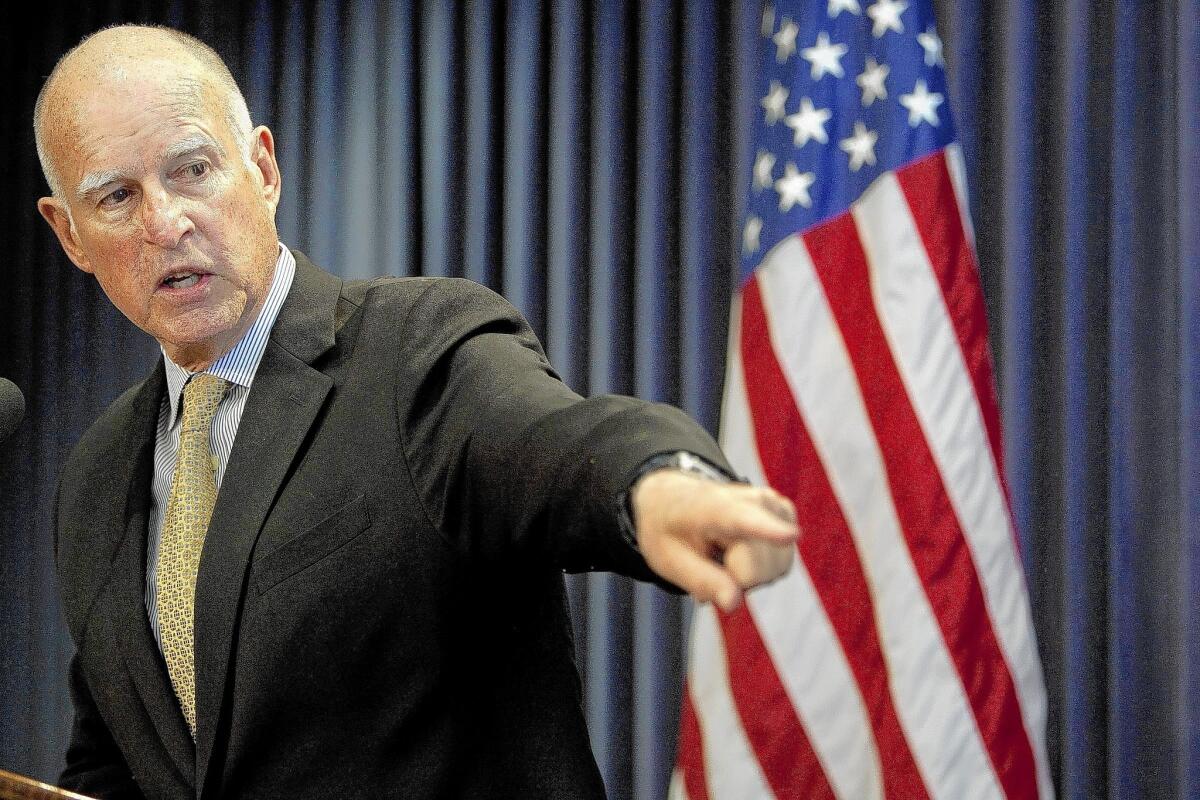Gov. Brown, lawmakers trade goodies to reach on-time budget

- Share via
Reporting from Sacramento — Old-fashioned horse trading, back scratching and leveraging — the proven path to successful legislating, especially budgeting.
It may emit a slight odor for the queasy. But it beats how, say, some Sunnis and Shiites settle their differences.
State budget compromising is much easier when the tax revenue flows reliably. For that, credit the recovering national economy and Gov. Jerry Brown’s soak-the-rich tax increase approved by non-rich voters two years ago.
If you’re the governor or a lawmaker, being able to spend a little extra here and there is a lot better for the psyche — and for dealing — than having to slash funding for school kids and the poor while raising taxes.
Lest we forget, those summer-long childish stalemates that made Sacramento a laughingstock and the politicians hated are nightmares of the past principally because Californians in 2010 reduced the legislative vote requirement for budget passage from two-thirds to a simple majority.
And to prevent procrastination, the electorate decreed that legislators would lose their pay if they didn’t pass a state budget by June 15. That was Sunday.
Brown and fellow Democrats — Republicans now are largely irrelevant because there are so few — reached agreement on a $156-billion spending compromise last week.
The governor — a virtual cinch to be wielding power for another four years — got pretty much what he wanted, starting with some funding for his unpopular bullet train. But he had to give a bit in order to jump-start the train and move it off the side track.
Legislative leaders agreed to appropriate $250 million in legally suspect cap-and-trade greenhouse emission fees — pollution licenses — to fund land acquisition, roadbed prepping and other steps necessary before track-laying can begin between Madera and Bakersfield.
The $250 million will enable the state to tap into federal money, which must be matched. Roughly $3 billion from Washington is available, but no more is in sight for the $68-billion Los Angeles-to-San Francisco project.
Bakersfield Rep. Kevin McCarthy — now No. 3 in the House Republican leadership and expected soon to be No. 2 — has made it his personal mission to block any further federal funding. “The high-speed rail boondoggle has proven to be an unfeasible project,” he asserted last week.
California voters in 2008 authorized selling $9 billion in state bonds for the bullet train. Of that, $8.6 billion remain. But a judge has held up their sale until the rail agency can specify where the other billions will come from to complete the first segment of the line to the San Fernando Valley.
The budget deal included not only $250 million for the train in the next fiscal year, but 25% of cap-and-trade fees in future years. Nobody seems to know how many hundreds of millions of dollars that will raise annually. Additionally, another stash of cap-and-trade money totaling $400 million was allocated to the train.
Brown had requested 33% of the pollution fees for his train. Senate leader Darrell Steinberg (D-Sacramento) offered only 15% initially. But the senator compromised at 25% when the governor loosened up and gave him some goodies.
The governor was desperate and, Steinberg acknowledges, “We used high-speed rail for leverage.”
Brown agreed to allocating 35% of cap-and-trade revenue for a mix of “green” projects: local transit, intercity rail and affordable housing, a favorite of new Assembly Speaker Toni Atkins (D-San Diego). The remaining 40% of the pollution fees will be spent on natural resources and clean energy.
Steinberg’s main victories, however, were in securing $264 million in tax money for early childhood education and $250 million for a “career pathways” program — what used to be called vocational ed or shop.
Brown had been cool — even hostile—toward Steinberg’s proposal to expand pre-kindergarten. They compromised on allowing it just for poor kids.
The hard-nosed bargaining didn’t occur in a traditional smoke-filled room, but — symptomatic of the era — in a cellphone conversation while Steinberg was grocery shopping on a Saturday evening.
The governor already had nailed down his other top priority: a proposed rainy day reserve, also championed by former Assembly Speaker John A. Pérez (D-Los Angeles).
For months, Brown had talked tough about being a fiscally prudent skinflint, but gave in to Democrats who insisted on raising welfare grants 5%.
He also wound up permitting home care workers to be paid overtime, acquiescing to Democrats and unions.
But the governor refused to reverse a 10% cut in pay rates for doctors who treat patients in the Medi-Cal program that is greatly expanding under Obamacare. Because of the measly rates — lowest in the nation — more and more doctors are refusing to accept Medi-Cal patients.
And, shamefully, no one even tried to restore previously cut funding for the most vulnerable: the aged, blind and disabled poor living entirely off federal and state subsistence programs (SSI/SSP) — $880 monthly for singles and $1,480 for couples.
There are roughly 1.5 million Californians receiving SSI/SSP, which was reduced to the federal minimum during the recession. The state is still stiffing them. They’re not unionized and can’t make campaign contributions.
Meanwhile, legislators keep raising the minimum wage, bumping up inflation and squeezing these impoverished folks even more.
So the governor and Democrats shouldn’t be patting themselves on the backs all that much for their budget compromise.
Brown did manage to get his choo-choo chugging. But you don’t hear him or anyone else in the Capitol bragging about it very loudly.
More to Read
Sign up for Essential California
The most important California stories and recommendations in your inbox every morning.
You may occasionally receive promotional content from the Los Angeles Times.














